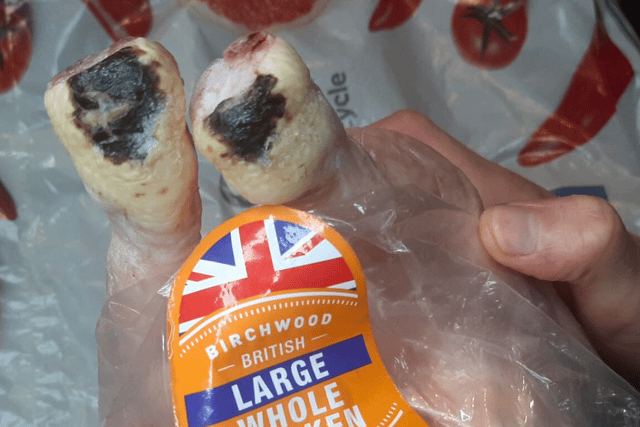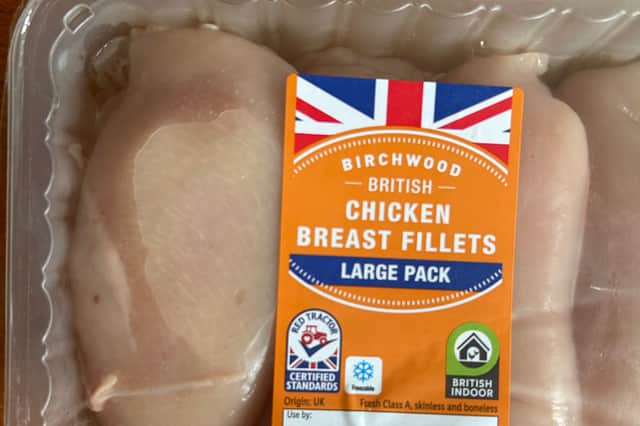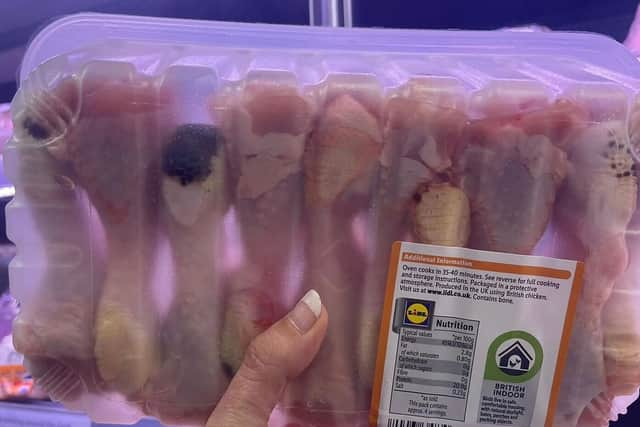Chicken welfare: New investigations suggest faeces 'burns' rife in UK supermarkets - in industry-wide issue
and live on Freeview channel 276
An animal welfare charity says it has found evidence of "revolting diseases" in chicken products sold at one major UK supermarket - while another investigation has hinted at much wider problems across the industry.
In a new report, Open Cages says it conducted a survey of chicken products sold in 40 different UK Lidl stores, to investigate the prevalence of 'hock burns'. These are brownish ulcers sometimes seen on the leg joints of chickens. They are a form of contact dermatitis, linked with the chicken's legs being exposed to ammonia - usually from urine and faeces. Eating meat with hock burns on it is not known to be harmful to consumers.
Advertisement
Hide AdAdvertisement
Hide AdThe charity said of the whole birds examined, it detected hock burns on 74% of them, although the supermarket says the findings are wildly out of step with their own. It also claimed members detected ‘white striping disease’ in 94% of Lidl’s packaged chicken breasts - a muscle disorder characterised by white lines across the breast meat, linked to poultry growing to large sizes rapidly. Open Cages says breast meat affected by white striping can be higher in fat content.
The BBC has also released its own, broader investigation, using supermarkets' self-reported hock marking figures - which include marks that have not yet developed into hock burns. It hinted at an industry-wide problem, with other brands' figures as much as six times higher than those Lidl reports. However, Open Cages is calling on Lidl to lead other British retailers by signing up to the Better Chicken Commitment (BCC) - a set of international, improved welfare standards for broiler hens.


What did NationalWorld find?
NationalWorld staff carried out a spot check on chicken products available at a South London Lidl, as well as at three other stores owned by different supermarket chains in the same part of the city.
Looking at dozens of whole chickens, as well as packaged thighs and drumsticks, at the Lidl, we found no evidence of hock burns. However, we did find what appeared to be 'white stripe disease' on a large majority of the chicken breasts on offer. Photos of these markings sent through to Open Cages, which described them as a "clear example" of the disease.
Advertisement
Hide AdAdvertisement
Hide AdSimilar white striping was noticed on chicken breast products at all three of the other stores too. No hock burns were noted on whole chicken products, although they were found on drumsticks at one of the other stores.


What does Lidl say?
Lidl says that Open Cages' findings do not match up to their own figures. A spokesperson shared figures from their two chicken suppliers, Avara and Cranswick, which noted hock markings (which are less severe than full-on hock burns) on an average of 4.8% and 6% of chickens checked, respectively. Avara clarified that they checked 100 chickens, or 200 hocks, from each lorry-full of hens transported - about 1.9% of total chickens processed.
"We take animal welfare extremely seriously, and the health of animals in our supply chain is closely monitored, with regular independent audits carried out to ensure that expected standards are being met. The figures provided by Open Cages strongly conflict with our own data, which is lower than industry figures publicly available," Lidl said.
The company said it fully supported the goals of improving animal welfare standards in poultry farming, and was working in close partnership with suppliers throughout its entire supply chain, "to ensure that we are continually enhancing standards whilst also responding to what our customers want from us". They continued: "Through this approach, we can set realistic measures and minimum targets for ourselves and our suppliers that can be implemented progressively within our range."
Advertisement
Hide AdAdvertisement
Hide AdIn the UK, all fresh chicken supplied to Lidl stores complied with nationally recognised third-party standards, including Red Tractor and RSPCA Assured, the supermarket's spokesperson said. "Additionally, Lidl GB’s free-range RSPCA Assured chicken meets and exceeds the requirements of the Better Chicken Commitment. To fully meet the requirements of the Better Chicken Commitment, sector-wide collaboration from market leaders across the industry is required."


How do other supermarkets stack up?
Of the supermarkets which agreed to release their hock marking data to the BBC, Co-op and Aldi reported the highest hock marking rates. Co-op reported it in 36.7% of its poultry, while Aldi found it in 33.5%. Tesco recorded a 26.3% rate, while Sainsbury's was at about 20%. Waitrose had the lowest figure, at just 2.7% of birds.
NationalWorld approached Co-op and Sainsbury's for comment, but they had not responded as of the time of publication. An Aldi spokesperson said: “We take animal welfare extremely seriously and work closely with our suppliers to ensure continuous improvement in our food and non-food products. We record and publish welfare data to ensure transparency.”
Tesco used a present-or-not-present system for recording any hock markings at all, which may have inflated its figures. The supermarket publishes these annually - in a bid to be transparent and improve its practices.
Advertisement
Hide AdAdvertisement
Hide AdA Waitrose spokesperson said they had worked closely with their supplier to maintain high animal welfare standards - to try and set themselves apart from other supermarkets. "Between 2014 and 2022 we reduced hock marking levels by 80%. Today, the overwhelming majority of our birds are free of any hock marking, and it's our ambition to make hock burn a thing of the past.
"We have achieved this by closely monitoring environmental conditions including ventilation and water pressure, investment in new temperature control, and ongoing farmer training. We are proud of the significant progress we've made to date, and continue to work on improving our already high welfare standards across our poultry farms," they said.
Providing additional context, Open Cages' Connor Jackson told NationalWorld they had chosen to investigate Lidl specifically, because they had received an anonymous tip. "They told us that they had seen many of these burns on the meat and wanted us to check it out," he said.
While they had conducted investigations into other UK supermarkets in the past, Mr Jackson said they were a charity with limited capacity - hence why they had not investigated industry-wide. Although only the seventh biggest supermarket franchise in the UK, Lidl [via the wider Schwarz Group] is the largest retailer in Europe, and he said its support could help drive others to adopt the BCC. "They have a uniquely powerful influence on the future of animal welfare. If Lidl moves on this, then everyone moves. So we feel that with great power comes great responsibility."
What do animal welfare experts say about hock burn?
Advertisement
Hide AdAdvertisement
Hide AdThe government's Department for Environment, Food & Rural Affairs (Defra) says in its code of practice for meat chickens that conditions such as hock burn were usually consequences of poor litter quality. "Well-designed equipment and high standards of management are important if good litter quality is to be maintained. The ventilation capacity should be sufficient to remove excess moisture. The feed composition should be well balanced to avoid problems with wet or sticky droppings."
Defra said specialist advice should be sought and acted on by farmers, "and stocking density should be reduced in subsequent flocks if poor litter quality cannot be rectified".
Veterinary animal welfare expert Andrew Knight, an adjunct professor at Australia's Griffith University, said of Open Cages' report: "Fast-growing chicken breeds and overcrowded conditions are used by some supermarkets in an attempt to maximise profits, but chickens can suffer as a result. This is indicated by meat characteristics such as hock burns and white striping disease, which consumers can see with their own eyes."
The report highlighted just how prevalent these conditions were in UK meat chickens, he continued. "The results are chronic suffering for many millions of chickens, and poorer meat quality. The solution is to use slower-growing chicken breeds with more space, as advocated by the Better Chicken Commitment."
Comment Guidelines
National World encourages reader discussion on our stories. User feedback, insights and back-and-forth exchanges add a rich layer of context to reporting. Please review our Community Guidelines before commenting.
